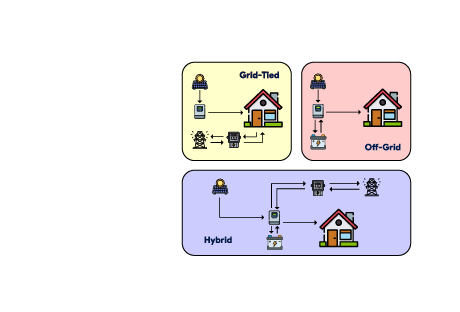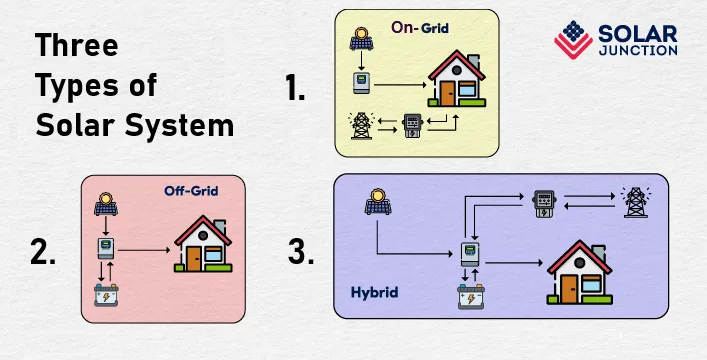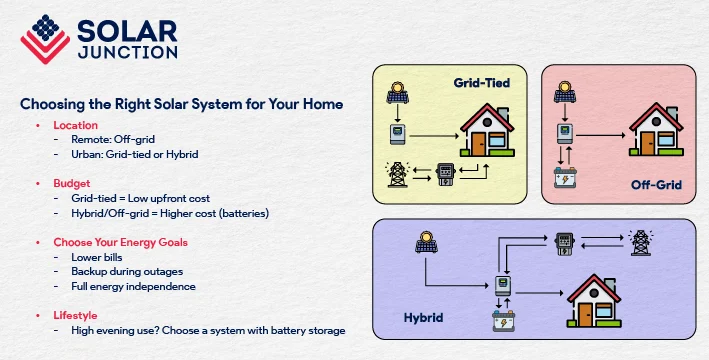On-Grid vs. Off-Grid vs. Hybrid Solar Systems: Which Is Best for You in Australia?
HOME > On-Grid vs. Off-Grid vs. Hybrid Solar Systems: Which Is Best for You in Australia?

As solar energy becomes an increasingly popular solution for powering homes, choosing the right system type is crucial. From urban homes with access to the grid to remote properties relying solely on solar power, Australians have several options.
This guide compares the three main solar panel system types - grid-connected solar systems, off-grid systems, and hybrid solutions - so you can determine the best setup for your energy needs, location, and long-term goals.

On grid solar system is the most common type in Australian households. It connects your solar panels directly to the main electricity grid, allowing you to draw power when your system isn't generating enough and feed excess electricity back to the grid.
Key Features
An off-grid system is completely independent of the electricity grid. It requires solar system with battery storage to function, as all generated power must be stored and used on-site.
A hybrid solar system Australia combines the benefits of a grid-connected solar system and energy storage solutions.
It allows your home to use stored solar power first, then draw from the grid when needed. Excess energy can still be sent to the grid for credits.
|
Features |
On-Grid |
Off-Grid |
Hybrid |
|
Connection to Grid |
Yes |
No |
Yes |
|
Battery Storage |
Optional |
Required |
Required |
|
Use of Feed-in Tariffs |
Yes |
No |
Yes |
|
Works During Blackouts |
No |
Yes |
Yes (with backup) |
|
Upfront Cost |
$$ |
$$$$ |
$$$ |
|
Maintenance |
Low |
High |
Medium |
|
Energy Independence |
Low |
High |
Medium-High |
The comparison table clearly highlights the key differences between on-grid, off-grid, and hybrid solar systems, helping homeowners make an informed decision based on their energy needs and location.
No matter which system you choose, energy storage solutions have become increasingly important. These systems help you store excess energy for use at night or during blackouts.
Whether you opt for a solar system with battery storage or a full home solar with battery backup, storage adds resilience and cost-saving potential to your setup.
Today's leading storage technologies, such as lithium-ion batteries (like Tesla Powerwall or LG Chem), offer high efficiency, compact design, and smart monitoring.
For hybrid and off-grid systems, storage is essential, but even grid-tied homes are increasingly adding batteries to reduce grid reliance and gain control over when and how they use their solar power.
One of the biggest incentives for choosing on-grid solar system or hybrid setup is the availability of solar feed-in tariffs. These are payments or credits you receive for exporting unused solar energy to the grid.
While rates vary between states and retailers, they still help offset your electricity costs and improve your return on investment.
However, feed-in tariffs have been decreasing in recent years, which is why many homeowners are now opting to store their energy rather than sell it back, especially with the growing affordability of energy storage systems.

When choosing the right solar system for your home, consider the following:
Consulting with an experienced solar provider like Solar Junction can help you assess your usage patterns, roof space, and system compatibility to choose the most efficient and cost-effective solution.

Whether you choose on-grid solar system, off-grid setup, or a hybrid solar system in Australia, each offers unique benefits depending on your energy needs and goals.
As battery technology becomes more affordable and efficient, more Australians are embracing energy storage systems to maximise their energy independence and resilience.
At Solar Junction, we provide expert advice and tailored solutions to help you navigate the evolving world of solar energy. today to find the ideal solar system for your home and take the first step toward cleaner, smarter, and more sustainable living.
